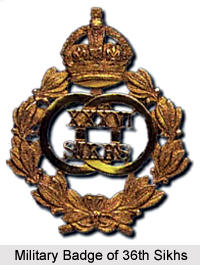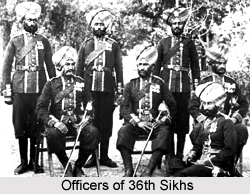 The 36th Sikhs unit was an infantry regiment of the British East India Company. The battalion was raised in the year 1887 and remained in service till the year 1922. It was a division of the Bengal Army of the Bengal Presidency. The 36th Sikhs unit was also included as a part of the Bengal Command. The proper administration of the Presidency Armies in British India was managed by a formal hierarchy. The infantry regiments of Bengal army were modified frequently and were under the administrative authority of British East India Company. Afterwards the British Empire in India gained control over the 3 British Presidency Armies (the Madras Army, the Bombay Army and the Bengal Army). It was also titled as the 35th (Sikh) Bengal Infantry.
The 36th Sikhs unit was an infantry regiment of the British East India Company. The battalion was raised in the year 1887 and remained in service till the year 1922. It was a division of the Bengal Army of the Bengal Presidency. The 36th Sikhs unit was also included as a part of the Bengal Command. The proper administration of the Presidency Armies in British India was managed by a formal hierarchy. The infantry regiments of Bengal army were modified frequently and were under the administrative authority of British East India Company. Afterwards the British Empire in India gained control over the 3 British Presidency Armies (the Madras Army, the Bombay Army and the Bengal Army). It was also titled as the 35th (Sikh) Bengal Infantry.
History of 36th Sikhs
The 36th Sikhs infantry regiment was founded in 1887 as the 36th (Sikh) Bengal Infantry by the English East India Company. The military unit was renamed later as the 36th Sikh Infantry in 1901. After the Kitchener reforms in the British Indian Army in 1903, the regiment was designated as the 36th Sikhs.
Military Operations of 36th Sikhs
 The 36th Sikhs participated in a number of battles and British campaigns. The troops fought in the Battle of Saragarhi against Pathans in defence of the Samana Ridge. The regiment later took part in the 1905 Rawalpindi Parade to honour the Prince and Princess of Wales during their visit to India. It also fought in the First World War and provided valuable military services. The armed force was posted in China and was included as part of the Garrison of Tianjin. The 36th Sikhs infantry regiment also participated in the Siege of Tsingtao.
The 36th Sikhs participated in a number of battles and British campaigns. The troops fought in the Battle of Saragarhi against Pathans in defence of the Samana Ridge. The regiment later took part in the 1905 Rawalpindi Parade to honour the Prince and Princess of Wales during their visit to India. It also fought in the First World War and provided valuable military services. The armed force was posted in China and was included as part of the Garrison of Tianjin. The 36th Sikhs infantry regiment also participated in the Siege of Tsingtao.
After the First World War, the British Government of India renumbered the British Indian Army. Many multi battalion regiments comprising 4 to 6 battalions were raised by joining the single battalion infantry units. The 35th Sikhs regiment was re-numbered as the 4th Battalion 11th Sikh Regiment in the year 1922.
Development of 36th Sikhs
After the political withdrawal of the British Empire in India on 15th August 1947, the nation became a sovereign state. The country was divided by the Partition of India into the Union of India and the Dominion of Pakistan. As an effect, the British Indian Army was also split among the 2 new countries of India and Pakistan. The 36th Sikhs infantry regiment was assigned to the modern Army of independent India.



















